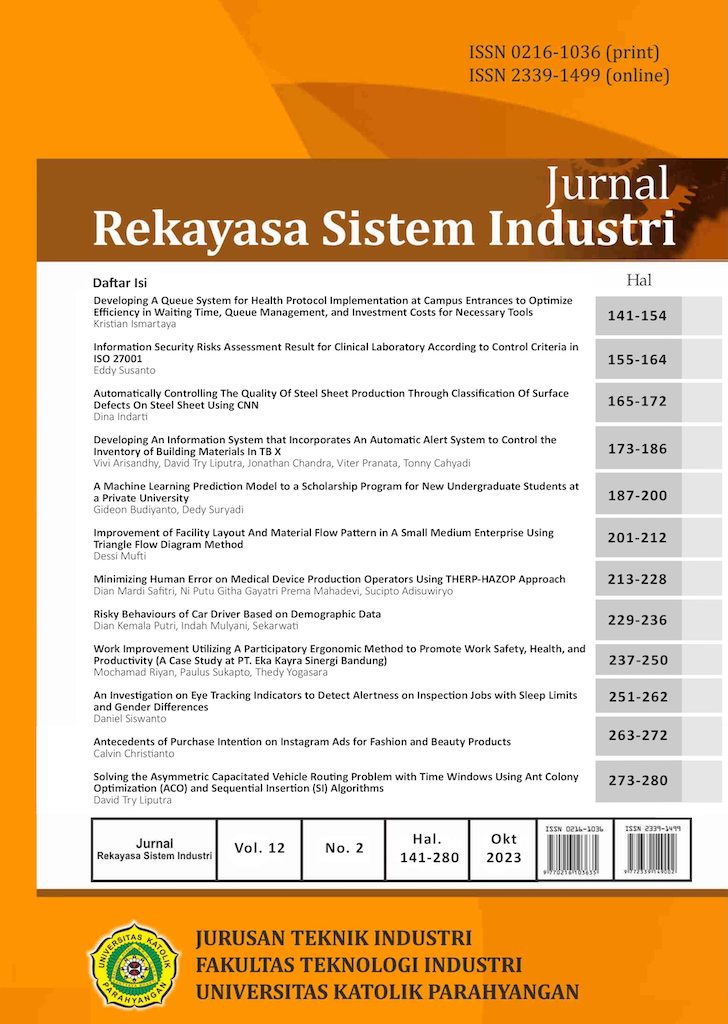Risky Behaviours of Car Driver Based on Demographic Data
DOI:
https://doi.org/10.26593/jrsi.v12i2.6589.229-236Keywords:
age, gender, risky driving behaviour,Abstract
The biggest cause of vehicle accidents is the human factor, one of which is risky driving behaviour. This study aims to provide an overview of the driving behaviour of some drivers and look at the demographic factors (age, gender, driving experience, type of vehicle) behind it. The quantitative approach was used in this study, with descriptive analysis techniques and t-tests on the participant groups. The results of the analysis of 108 drivers as participants in this study indicate that age and gender are factors that can cause car drivers to exhibit risky driving behaviour (speeding, changing lanes, and overtaking vehicles in front). Furthermore, men are more likely to engage in risky driving behaviour, and the older they get, the less likely they are to engage in risky driving behaviour.
References
Agung, I.M. (2014). Model perilaku pengendara berisiko pada remaja. Jurnal Psikologi Integratif, 2(2), 35-41.
Akinniyi, R. J., Akinnawo, E. A., Akpunne, B. C., & Oyeleke, J. T. (2019). The Predictive Influence of Demographic and Personality Traits on Risky Driving Behaviour among Traffic Offenders in Osun State, Nigeria. Current Journal of Applied Science and Technology, 35(4), 1-12.
Amalia, F.M. & Nurmansyah, M.I. (2020). Perilaku berisiko dalam berkendara dan kejadian kecelakaan sepeda motor pada mahasiswa. Window of Health: Jurnal Kesehatan, 3(4), Hal. 271-286.
Bachoo, S., Bhagwanjee, A., & Govender, K. (2013). The influence of anger, impulsivity, sensation seeking and driver attitudes on risky driving behaviour among post-graduate university students in Durban, South Africa. Accident Analysis & Prevention, 55, 67-76.
Bonem, E., Ellsworth, P., & Gonzalez, R. (2014). Age differences in risk: Perceptions, intentions and domains. Journal of Decision Making, 28 (4), 317-330.
Burr, D.A., Castrellon, J.J., Zald, D.H., & Larkin, G.R.S. (2020). Emotion Dynamics Across Adulthood in Everyday Life: Older Adults Are More Emotionally Stable and Better at Regulating Desires. Emotion. http://dx.doi.org/10.1037/emo0000734.
Carey, RN. (2013). The impact of threat appeals on risky driving behaviors. Doctoral dissertation, National University of Ireland. Citiseer.
Chen, C. F. (2009). Personality, safety attitudes and risky driving behaviors— Evidence from young Taiwanese motorcyclists. Accident Analysis & Prevention, 41(5), 963-968.
De Bruin, W.B., Parker, A.M., & Fischhoff B. (2012). Explaining Adult Age Differences in Decision-making Competence. Journal of Behavioral Decision Making, 25, 352–360.
Deffenbacher, J. L., Lynch, R. S., Oetting, E. R., & Swaim, R. C. (2002). The Driving Anger Expression Inventory: A measure of how people express their anger on the road. Behaviour research and therapy, 40(6), 717-737.
Febrianti, A., Yassierli, dan Mahachandra, M. (2016). Evaluasi tingkat kelelahan pada pengemudi bus di kota Bandung. Jurnal Rekayasa Sistem Industri, 5(2), Hal. 118-127.
Gibbons, F.X., Kingsburry, J.H., Gerrard, M. (2012). Social-Psychological Theories and Adolescent Health Risk Behavior. Social and Personality Psychology Compass, 6(2), 170–183.
Gopalakrishnan, S. (2012). A public health perspective of road traffic accidents. J Fam Med Primary Care, 1(2), Hal. 44-50.
Irianti, L. (2017). Pengaruh shift kerja terhadap kelelahan dan performansi pengendali kereta api Indonesia. Jurnal Rekayasa Sistem Industri, 6(2), Hal . 79-92.
Iversen, H. (2004). Risk-taking attitudes and risky driving behaviour. Transportation Research Part F, 7, 135–150.
Korlantas POLRI. (2021). Data Kecelakaan di Indonesia. Manuskrip tidak dipublikasikan. Kepolisan Lalu Lintas Republik Indonesia.
Lady, L., Marliana, P., dan Umyati, A. (2014). Kajian kecelakaan kapal di pelabuhan Bandten menggunakan human factors analysis and classification system (HFACS). Jurnal Rekayasa Sistem Industri, 3(2), Hal. 46-52.
Lucidi, F., Mallia, L., Lazuras, L., & Violani, C. (2014). Personality and attitudes as predictors of risky driving among older drivers. Accident Analysis and Prevention, 72, 318–324.
Machado-León.,J.L., De Oña, J., De Oña, R., Eboli,L., & Mazzulla, G. (2016). Socio-economic and driving experiences factors affecting drivers’ perceptions of traffic crash risk. Transportation Research Part F: Traffic Psychology and Behaviour, 37, 41-51.
Machin, M.A., & Sankey, K.S. (2008). Relationships between young drivers’ personality characteristics, risk perceptions, and driving behavior. Accident Analysis & Prevention 40 (2). 541-547.
Maulina, D., Danilasari, K.R., Nazhira, F., & Jufri, S,S. (2018). Why riders perform risky riding behavior in Jakarta: The effects of hazardous situation, gender, and risk perception. Psychological Research on Urban Society, 1 (1). 38-45.
Neubauer, C., Matthews, G., & Saxby, D. (2012). The effects of cell phone use and automation on driver performance and subjective state in simulated driving. In Proceedings of Human Factors and Ergonomics Society Annual Meeting. Vol.56. No.1. pp. 1987-1991. Sage CA: Los Angeles. Sage Publications.
O’Brien, F., Bible, J., Liu, D., & Simons-Morton, B.G. (2017). Do young drivers become safer after being involved in a collision? Psychological Science, 28(4). 407-413.
Patil, S.M., Shope, J.T., Raghunatahan, T.E., & Bingham, C.R. (2006). The role of personality characteristics in young adult driving. Traffic Inj Prev, 7(4), 328-334.
Rachmatunnisa, F. & Bagaskara, S. (2021). Peran locus of control dan sikap pro risiko terhadap perilaku mengemudi berisiko. Jurnal Penelitian Transportasi Darat, 23(2), 135-141.
Rolison, JJ., Regev, S., Moutari, S., & Feeney, A. (2018). What are the factors that contribute to road accidents? An aseessment of law enforcement views, ordinary drivers’ opinions, and road accident records. Accident Analysis and Prevention, 115, 11-24.
Safrilah, Putra, J.C.P., & Ihsan,M. (2018). The Development of Driving Behavior Questionnaire to Determine Roadway Capacity. AIP Conference Proceedings. Doi: https://doi.org/10.1063/1.504299.
Sagberg, F., Giulio, S., Piccinini, F.B., & Engstrom, J. (2015). A review of research on driving styles and road safety. Human Factors, XX(X), 1–28 DOI: 10.1177/0018720815591313.
Satiarida, A. & Yanuvianti, M. (2019). Hubungan stres berkendara dengan perilaku mengemudi berisiko pada pengendara sepeda motor di Bandung. SPeSIA UNISBA, 5(2), 703-709.
Triman, A., & Bagaskara, S. (2017). Peran trait kepribadian terhadap perilaku mengemudi pengendara bermotor di Jakarta. Jurnal Psikogenesis, 5(2) 150-158.
Ӧzkan, T. & Lajunen, T. (2006). What causes the differences in driving between young men and women? The effects of gender roles and sex on young drivers’ driving behaviour and self-assessment of skills. Transportation Research Part F, 9, 269–277.

